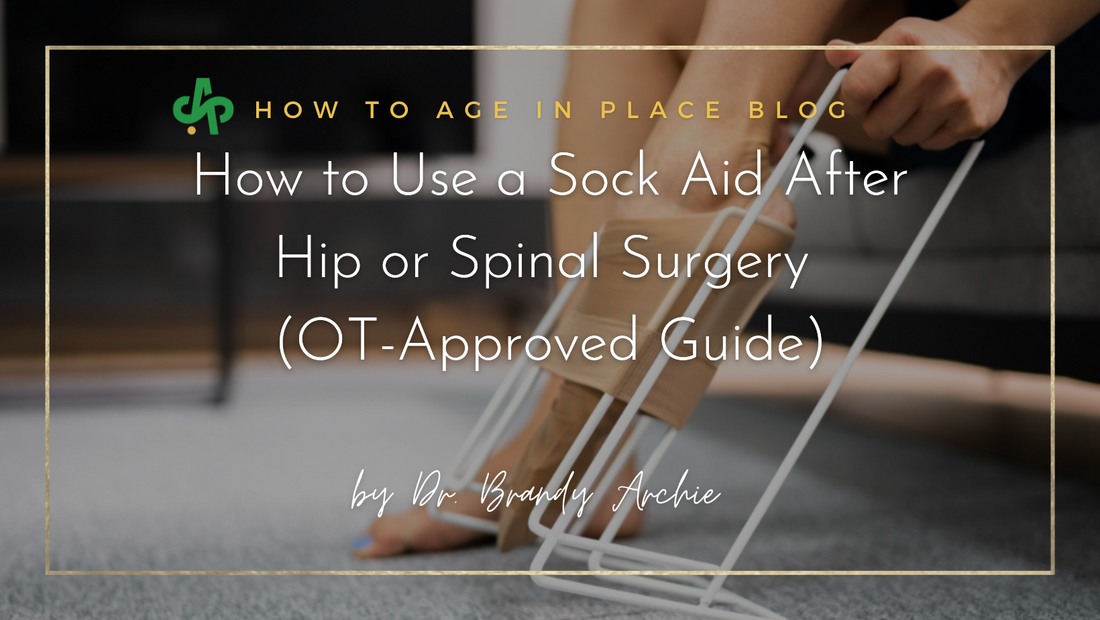Putting on socks after hip or spinal surgery can feel frustrating or even impossible—but it doesn’t have to be. A sock aid is an adaptive tool that helps you put on socks without bending over, reducing strain on your back, hips, or knees. Whether you're recovering from surgery or dealing with chronic pain or mobility challenges, this step-by-step guide from an occupational therapist walks you through how to use a sock aid safely and effectively.
What is a sock aid and how should you use one?
A sock aid is a dressing tool that helps you put on socks without bending, ideal for anyone recovering from hip or spinal surgery or managing mobility loss.
Sock aids come in different styles—flexible, rigid, or hinged—and they’re designed to make getting dressed easier when reaching your feet is difficult or unsafe. You simply slide your sock onto the device, lower it to the floor using the long straps, insert your foot, and pull. Your sock slips on without the need to bend over.
Sock aids are commonly recommended by OTs for:
-
Hip replacement recovery
-
Spinal surgery recovery
-
Arthritis or chronic pain
-
Seniors with balance or flexibility challenges
Looking for the right option? Try an OT-approved model like the Flexible Sock Aid, Wide Rigid Sock Aid, or Hinged Compression Sock Aid.
How do you put a sock on a sock aid?
Lay the sock over the aid so the toe is flat and secure; bunching at the bottom is fine as long as the top is smooth and open for your foot.
The key to success with a sock aid is sock placement. Here’s how to load it properly:
-
Choose a clean, dry sock—standard or compression, depending on your needs.
-
Slide the sock over the plastic shell with the toe flat and aligned to the end.
-
Open the cuff wide, ensuring there's enough space for your foot to enter.
-
Bunched material at the heel is okay—what matters most is a smooth top surface for a clean slide.
This is especially important for compression socks, which are tighter and less forgiving.
How do you use a sock aid to put on socks?
Sit on a stable surface, drop the sock aid to the floor, slide your foot in, and pull the handles upward to smoothly apply the sock.
Once your sock is in place, here’s how to use the aid:
-
Sit in a firm, stable chair with your knees at 90 degrees.
-
Hold the sock aid by the long straps and lower it to the floor between your feet.
-
Insert your foot carefully—wiggle your toes forward until they reach the end of the sock.
-
While keeping your leg stable, pull the handles up in a slow, steady motion.
-
The sock will slide over your foot and calf with minimal effort.
✅ Tip: For safety and control, always use your sock aid before standing or walking.
Can you use a sock aid if you have swelling or pain?
Yes—choose a flexible sock aid to reduce pressure on swollen feet, or a hinged model for easier entry if you're recovering from hip or spinal surgery.
Swelling and pain are common post-surgery or with chronic conditions like arthritis. That’s why choosing the right type of sock aid matters:
-
🧦 Flexible Sock Aid: Bends gently and accommodates minor swelling or tenderness.
-
🦶 Wide Rigid Sock Aid: Best for those with larger feet or thicker socks.
-
💪 Hinged Compression Sock Aid: Designed for tight-fitting compression socks with better leverage and control.
If pain limits your grip strength, look for models with easy-grip handles or adjustable cords to minimize stress on your hands and shoulders.
What type of surgery is a sock aid most helpful for?
Sock aids are especially helpful after hip replacement or spinal surgery, when bending and twisting are restricted during recovery.
After a hip replacement, patients are often told to avoid bending past 90 degrees or twisting the torso—this makes basic tasks like dressing more complex. Similarly, spinal surgery recovery limits forward bending, which makes reaching your feet unsafe or impossible.
Sock aids offer a way to stay independent while respecting post-op restrictions. They're also commonly paired with:
-
Long-handled shoehorns
-
Reachers or grabbers
-
Dressing sticks
These tools work together to reduce fall risk, support recovery, and keep you safe at home.
Tips for Getting the Most Out of Your Sock Aid
Practice with the help of a caregiver or OT at first, and set up your space for success.
To make the process smoother:
-
Sit in a chair with a non-slip surface
-
Keep your sock aid nearby, especially in the morning
-
Wear grip socks to reduce the risk of slipping
-
If you live alone, consider placing the sock aid by your bed or bathroom
-
Keep straps untangled and wipe the aid down as needed
👩⚕️ Want help choosing the right aid? AskSAMIE.com can match you with OT-recommended tools in just a few clicks.
Where can I buy an OT-approved sock aid?
Find therapist-trusted sock aids at AskSAMIE.com, where tools are selected for safety, comfort, and ease of use.
We don’t just list tools—we match you with the right one based on your needs, surgery type, and mobility level. Explore:
-
Flexible Sock Aid – best for gentle use
-
Wide Rigid Sock Aid – best for thicker socks or bigger feet
-
Hinged Compression Sock Aid – best for compression socks or limited grip
Final Thoughts: Regain Independence After Surgery—One Sock at a Time
A sock aid isn’t just a tool—it’s a simple way to maintain dignity and independence after surgery or injury. By learning how to use one correctly and choosing the style that suits your needs, you’re taking a major step toward making your daily routine safer and easier.
If bending is painful, if you’re worried about falling, or if dressing is taking longer than it should, try an OT-approved sock aid—and see how small adjustments make a big difference.
🔗 Visit AskSAMIE to find your perfect fit →


